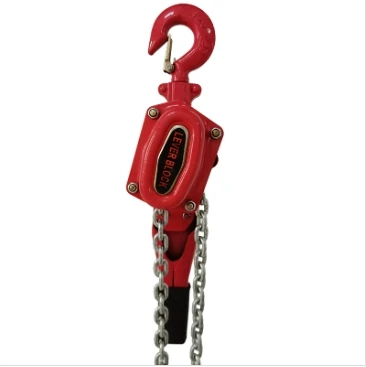


Understanding Lever Blocks A Comprehensive Overview
In the world of industrial lifting and material handling, lever blocks stand out as essential tools for various applications. Lever blocks, or lever hoists, are lifting devices that employ a lever mechanism to lift heavy loads effectively. They are widely used in construction sites, warehouses, and shipping yards, providing a reliable and efficient means of lifting, lowering, and positioning heavy objects.
The Mechanism of Lever Blocks
At its core, a lever block consists of a chain, lever arm, ratchet mechanism, and a hook for attaching the load. When the lever is pulled down, it engages the ratchet, allowing the chain to wind around a drum, which lifts the load. Releasing pressure on the lever allows the chain to lower the load smoothly. This mechanical advantage makes lever blocks exceptionally useful for heavy lifting in environments where power sources are limited or impractical.
The design of lever blocks is straightforward yet highly effective. The lever arm usually has three distinct positions lifting, lowering, and free-wheeling. This versatility allows the operator to manage loads with precision and control. Lever blocks are available in various load capacities, ranging from a few hundred pounds to several tons, making them suitable for diverse lifting tasks.
Applications of Lever Blocks
Lever blocks find applications across numerous industries. In construction, they are used to lift steel beams, heavy machinery, and scaffolding materials. In warehouses, they facilitate the movement of goods, aiding in inventory management and storage solutions. Lever blocks are also popular in automotive workshops for lifting engines or heavy parts, and in shipping for loading and unloading cargo.

One of the significant advantages of lever blocks is their portability. Unlike electric hoists or other mechanized lifting devices, lever blocks do not rely on electricity and can be used in remote locations. This feature makes them invaluable in outdoor applications or places without reliable power sources.
Safety and Maintenance
While lever blocks are generally safe to use, proper training and adherence to safety standards are crucial. Operators must be familiar with the equipment, understand weight limits, and ensure that all components are in good working condition before use. Regular inspections and maintenance are essential to prevent failures or accidents. Attention should be given to the condition of the chain, hook, and lever mechanisms to ensure safe operation.
The load capacity is another critical safety consideration. Overloading a lever block can lead to mechanical failure, causing injury or property damage. Operators should always check the manufacturer's specifications and be aware of the load limits to ensure safe handling.
Conclusion
In summary, lever blocks are invaluable tools in the realm of material handling and lifting. Their simple yet effective design, combined with a versatile range of applications, makes them a go-to solution for many lifting needs. Whether in construction, warehousing, automotive, or shipping, these devices provide the mechanical advantage necessary to lift and position heavy loads safely.
With proper training, maintenance, and adherence to safety guidelines, lever blocks can significantly enhance operational efficiency while ensuring the safety of workers and equipment. As industries continue to evolve, the reliance on reliable lifting solutions like lever blocks will remain a cornerstone of effective material handling practices.



